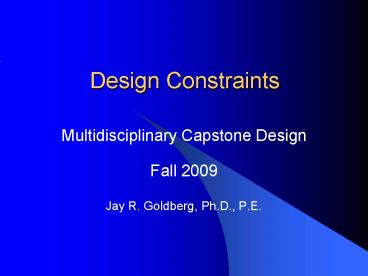Design Constraints - PowerPoint PPT Presentation
1 / 20
Title:
Design Constraints
Description:
all designs contain some element of danger. ... Disposability. Sustainability. Pollution, contamination, etc. Social/Cultural Design Constraints ... – PowerPoint PPT presentation
Number of Views:509
Avg rating:3.0/5.0
Title: Design Constraints
1
Design Constraints
- Multidisciplinary Capstone Design
- Fall 2009
- Jay R. Goldberg, Ph.D., P.E.
2
Design Constraints
- Engineering is design with constraints.
- all designs contain some element of danger. In
seeking to minimize danger, one usually increases
cost, and therein lies a dilemmaThere is no
trick to making an automobile that is as strong
as a tank and safe to ride in. The challenge is
to make an automobile that ordinary people can
afford and is as safe as the community thinks it
should be. There are also considerations of
style, economy of use, and effect on the
environment.
(Samuel Florman, Moral Blueprints)
3
- Constraints are rules or conditions that need to
be complied with or met. - Customer needs can help determine applicable
design constraints and requirements. - What constraints affect
- the final design of a product?
4
Customer Needs (Ex Medical Device Market)
- Lower cost
- Time savings
- Lower cost
- Reduced risk to patient
- Increased productivity/revenue
- Improved performance
- Higher quality of care
- More effective treatment
- Easier to use (improved safety)
- Reduced liability
5
Customer Needs
- New treatment
- Improved quality of care
- Lower cost?
- Increased revenues
6
Unique Attributes of Medical Device Market and
Resulting Design Constraints
- Third party payors (insurance companies,
Medicare, Medicaid) - cost constraints
- Strict regulatory system
- regulatory constraints
- Potential liability
- legal (safety) constraints
Management of Medical Technology, Geisler and
Heller, 1998
7
Technical Design Constraints
- Performance/functional requirements
- Usability
- Manufactureability
- Service life/maintenance
- Safety and efficacy (medical devices)
- Sterilizability (medical devices)
- Packaging and labeling
- Aesthetics
8
Economic Design Constraints
- Manufacturing costs (what will it cost to make?)
- Selling price (how much will customers pay for
it?) - Profitability (can we make a profit?)
- Price competition (what do competitors sell it
for?) - Additional constraints for medical devices
- Cost containment pressures from insurance
companies - Will insurance reimburse hospitals for product?
9
Legal Design Constraints
- Product liability
- Safety
- Patent issues
- Patentability
- Infringement
- Licensing
10
Regulatory Design Constraints
- May be regulated by government agencies (FDA,
EPA, OSHA, etc.) - Use of new material in medical device may require
clinical and other studies - Increases cost of project
- Lengthens project schedule
11
Regulatory Design Constraints
- Compliance with industry standards (ASTM, IEEE,
ASME, ISO, AAMI, etc.) - Will affect design
- May affect cost
- Compliance with quality standards
- Quality Systems (ISO 9001, FDA QSR)
- Require designs to meet customer needs
12
Environmental Design Constraints
- Energy efficiency
- Recycleability
- Disposability
- Sustainability
- Pollution, contamination, etc.
13
Social/Cultural Design Constraints
- Some products designed for the US market may not
be acceptable to foreign markets, may require
redesign - Some countries reuse medical devices
- Cannot dispose of PVC devices in landfills in EU
- Lack of reliable power source in less developed
nations
14
Design Constraints
Technical
Social
Economic
Acceptable Designs
Legal
Environmental
15
Example Ureteral Stent
- Long, soft, flexible tube with inner lumen
- Placed with cystoscope between kidney and bladder
to maintain urinary drainage - Contain retention curls and drainage holes,
radiopaque - Made of silicone, or other biocompatible materials
16
New Product Resorbable Stent
- Similar to existing ureteral stents
- Made of degradable materials
- Dissolves in body, retrieval procedure not needed
- Safer for patient
- Reduces cost of treatment
17
Technical Design Constraints/Requirements
- Performance requirements
- Functions for 2 weeks
- Gone after 4 weeks
- Provides drainage
- Safety requirements
- No migration
- No fracture
- No blockage, erosion, or perforation
- Other requirements
- Ease of placement
- Comfort
- Radiopacity
- Biocompatibility
- Sterilizability
- Adequate shelf life
- Manufactureability
18
Other Design Constraints
- Economic/Financial
- manufacturing cost lt 150
- if gt 150, stent must add value
- insurance must reimburse for device
- Legal
- prefer patent to exclude competitors, need to
develop new material - may need to license patent to avoid infringement
19
Other Design Constraints
- Regulatory
- use materials familiar to FDA to minimize cost
and time for clinical studies - must comply with ASTM standard for ureteral
stents - Environmental
- product degrades in body, no need for disposal
- recyclable packaging materials can be used
- Social, cultural
- none
20
Summary
- There are many constraints that affect product
design - Customer needs dictate many design constraints
(requirements) - Need to identify customer needs and design
constraints early in project to correctly define
project































